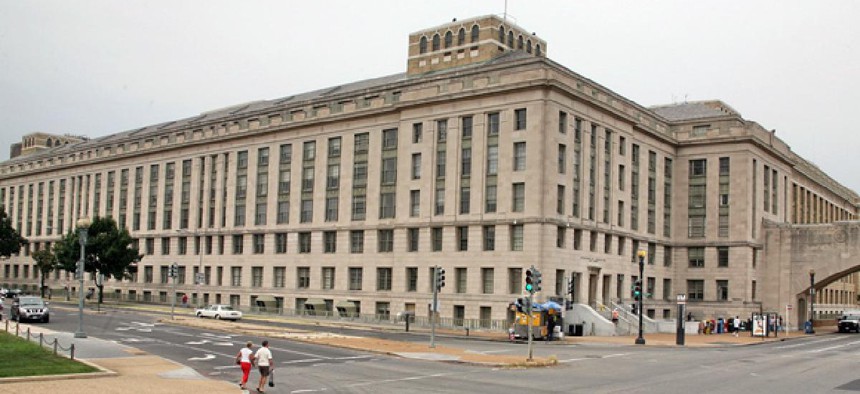
Agriculture Department headquarters Flickr user cliff1066
White House veto threat sets up clash on Agriculture’s buildings fund
Administration also objects to proposed USDA salary cuts.
The White House is challenging a move by House Republican appropriators to deny the Agriculture Department any funds in fiscal 2013 for repair and upkeep of its buildings.
When H.R. 5973, the fiscal 2013 agriculture spending bill, cleared the House Appropriations Committee by voice vote on June 19, it contained a sentence saying no funds would be included for the operations and maintenance portion of Agriculture’s buildings and facilities account, along with a 35 percent reduction for the departmental administration staff offices.
“The funding levels provided in this appropriations bill continue to demonstrate how seriously this committee takes the responsibility to walk back discretionary spending,” said the committee report. “The committee’s actions to reduce spending on the many agencies, programs and activities funded in this bill will help address the nation’s debt, deficit and economic challenges.”
Two days later, the Office of Management and Budget issued a veto threat that focused primarily on charges that the Republicans’ bill violated the 2011 Budget Control Act and on proposed cuts in well-known programs such as rural development, nutrition and international aid. But in a little noted passage of the statement of Obama administration policy, OMB blasted the proposed cuts of $55 million and $9 million respectively in building maintenance and staff office deployment.
“Consistent with the administration's efforts to reduce administrative costs, the department is streamlining services and cutting expenses by closing unnecessary offices, reducing travel and printing, and consolidating information technology contracts. The committee proposal to eliminate O&M funding entirely and the deep cut in the USDA-wide staff offices would put an unrealistic burden on agencies,” OMB noted.
The veto threat also protested House Republican plans to cut funding for salaries and expenses at USDA service centers connected to the Farm Service Agency, the Natural Resources Conservation Service and Rural Development.
“Each of these agencies has seen significant decreases in its administrative budget since 2010, which they have met through permanent staffing reductions using voluntary early retirement and separation authorities, delaying or eliminating the acquisition of important information technologies upgrades, office closures, and reductions for most other administrative expenses,” OMB said. “An additional 3 percent reduction could harm program delivery, delay rural economic development, and lead to longer waits for farm and home loans as well as assistance for farmers and ranchers.”
The Senate version of the agriculture spending bill, which cleared the Appropriations Committee in April, contains no such cuts. Its buildings and facilities budget of $241.3 million is split into three sections, rental payments, building security, and operations and maintenance. The Senate proposal matches the House proposal in the first two categories, but would allocate $52,169,000 for operations and maintenance, or about $3 million less than the president’s request as compared with zero in the House version.
When the president’s budget came out in February, the Agriculture Department asked for continuing funding in operations and maintenance to help with repairs, health and life safety issues and energy conservation in its two-building headquarters complex and George Washington Carver Center in Beltsville, Md. The department also asked for authority for the secretary to shuffle funds from previous years’ budgets as he consolidated offices and sought new efficiencies.
Just weeks before the fiscal 2013 budget was released, Agriculture Secretary Tom Vilsack announced that USDA was contributing to the Obama administration’s Campaign to Cut Waste by creating a Blueprint for Stronger Service. The plan will result in closures of 259 domestic offices, facilities and labs across the country, as well as seven foreign offices, for an estimated savings of $150 million annually.
Floor votes on the Agriculture appropriations bills will take place later in the summer, though the major farm authorization bill cleared the Senate this month and will be taken up by the House in July.
What is clear now is the department’s desire for continued and flexible funding as it reduces its facilities footprint does not fit with the deficit reduction plans of House appropriators. “This legislation,” said House Appropriations Chairman Hal Rogers, R-Ky., “represents a careful balance between fiscal restraint and responsible investments in programs to support an abundant and safe food and drug supply, promote U.S. interests in the global economy, and encourage economic development in our rural communities.”
NEXT STORY: Postal Service workers stage hunger strike







